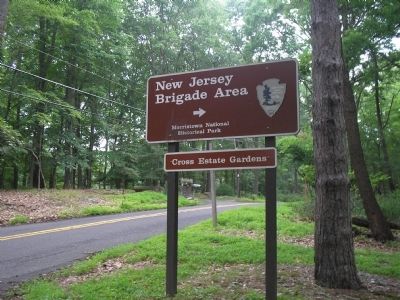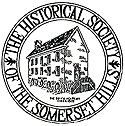Time: 10:00 am
Join Historical Society members for a 1.4-mile hike (60 minutes round trip) to the site of the New Jersey Brigade Encampment. There, interpretative signs explain the remains of the soldiers’ huts and the conditions the American army faced during the hard winter of 1779-80. Trail head parking is available at Morristown National Historical Park located on Jockey Hollow Road (off Hardscrabble Road) in Bernardsville.
Note, the trail is forested and steep in several places. Hikers are advised to wear appropriate shoes.
Sponsored courtesy of The Historical Society of the Somerset Hills
Email roycrego@gmail.com to reserve a spot or ask questions.

The New Jersey Brigade Encampment
In November 1779, during the Revolutionary War, the New Jersey Brigade returned to the state from central New York after participating in General John Sullivan’s campaign against the Iroquois Confederacy. Sergeant Major George Grant of Bernards Twp. served in the 3rd NJ Regiment and kept a diary of their movements. The troops arrived at Scotch Plains on November 5 and spent six weeks in tents “in the most severe and cold weather.” On December 17, Grant writes that the regiment marched to “Erye’s Forge” and began to construct their winter quarters. On December 24, 1779 they moved into the new log huts.
Erye’s Forge was a variant spelling for a business owned by Elisha Ayers near the junction of Indian Grave Brook and the Passaic River. The area, now in the Borough of Bernardsville, was part of a small community called Log Town that existed along Hardscrabble Road near the present Scherman Hoffman Wildlife Sanctuary. The encampment was south of the main army at Jockey Hollow, but offered access to water and local settlements at Basking Ridge and Vealtown (Bernardsville). The latter was reached by the road south that came to be known as Old Army Road.
The New Jersey brigade consisted of four regiments totaling just over 1,000 men. They were the 1st, 2nd and 3rd NJ regiments and Spencer’s Regiment, named after Col. Oliver Spencer, a tannery owner from Elizabethtown (Elizabeth). The other regimental commanders were Col. Mathias Ogden of Elizabethtown (1st NJ), Col. Israel Shreve from (2nd NJ) and Col. Elias Dayton of Elizabethtown (3rd NJ). A payroll from the 3rd New Jersey for December 1779 (see Exhibit 1) lists Col. Dayton, Sergeant Major George Grant, and other soldiers stationed at the site. The impact of the encampment on the surrounding area was significant and not always positive. Records from Spencer’s Regiment show soldiers sometimes scavenged for firewood:
April 11, 1780 “Frequent complaints having been made to the Brigadier that many of the soldiers are daily pulling down and destroying the fences near camp—the General requests that every officer will exert himself to detect and bring to punishment all who may be found guilty of such irregularitys [sic] and all centinells [sic] are strictly ordered to prevent any rails being brought into camp.”
The soldiers undoubtedly had great need for firewood. In March 1780,
General Washington wrote from his headquarters in Morristown, “The
oldest people now living in this Country do not remember so hard a Winter
as the one we are now emerging from.”
The brigade left their encampment along Hardscrabble in April 1780 and moved north into Jockey Hollow to occupy the empty huts of the Maryland Line. They left Jockey Hollow in May 1780 and played a major role in repelling British incursions into New Jersey at Connecticut Farms (Union) on June 7 and at Springfield on June 23, 1780.
The NJ brigade encampment was long forgotten but rediscovered in 1967 through the research of Fred and Isabel Bartenstein of Mendham Township. The site was found on land then owned by the New Jersey Audubon Society. Archaeologists excavated the remains of the huts, which measured 12 by 14 feet and were laid out in groups of four along the hillside. Many of the huts had been built into the hillside to provide additional shelter and warmth. An old camp road separated the soldiers’ huts from ten officers’ huts. The buildings were of log construction and featured stone fireplaces, several of which were excavated in 1968 (See Exhibit 2). Exhibit 3 shows the remains of what may be the same fireplace during
a visit in 2022.
In 1969, the Audubon Society donated the 25.45-acre tract containing the site to the National Park Service, which added it to Morristown National Historical Park. Acquisition by the Park Service also spelled the end of state plans to build the proposed Hardscrabble reservoir in the area.
The New Jersey Brigade site is open to the public from the parking area of the Cross Estate off Jockey Hollow Road in Bernardsville. Hikers can also access the site from the Scherman Hoffman Wildlife Sanctuary.
George S. Conover, comp., Journals of the Military Expedition of Major General John Sullivan Against the Six Nations of Indians in 1779, Auburn, N.Y. : Knapp, Peck & Thompson, 1887, p. 114.
“United States Revolutionary War Rolls, 1775-1783,” database with images, FamilySearch.org, citing NARA microfilm publication M246.
Orderly Book, Colonel Spencer’s Additional Regiment, April 9, 1780 to June 6, 1780. Morristown NHP Library Photocopy collection.
George Washington to Marquis de Lafayette, March 18, 1780, Varick Transcripts, Library of Congress.
Dig Reveals 1779-80 Hut, Bernardsville News, Apr. 11, 1968, pp. 1 and 5.
John F. Luzader, The New Jersey Encampment, a Special Study, Exhibit V, preliminary report by Robert Ditchburn, National Park Service, 1968.
National Register of Historic Places Inventory, Nomination Form, NJ Brigade Encampment Site, May 1979, pp. 6-7.
Bernardsville Tract In National Park, Bernardsville News, May 1, 1969, p. 1.



